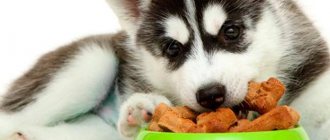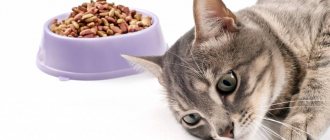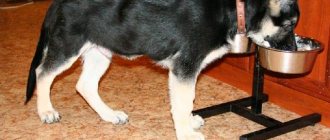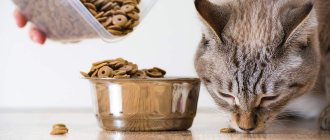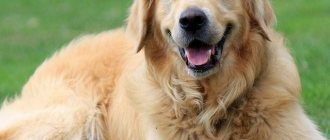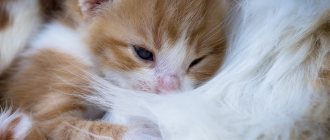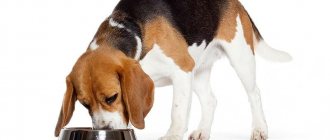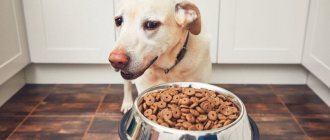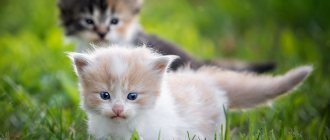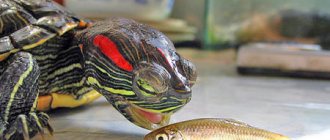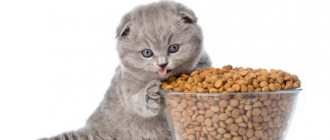Making a diet for a kitten
Every cat lover will be very happy and immensely happy when a little furry friend - a kitten - appears in his home. This cute ball of fur will make anyone smile even on the stormiest day, will always give its owner a piece of his enthusiasm and infect him with positivity.
A small pet already has its own character and habits, but it still requires attention and education. And in order for a tiny organism to grow and develop properly, it is necessary to take care of the optimal diet for it.
How to feed a newborn kitten without a cat
There are very sad cases when a mother cat dies after giving birth or a similar force majeure occurs. And if there is no other cat or even a small dog nearby that can feed the babies, then the person will have to take care of feeding the orphaned kittens on their own.
Kittens age from 0 to 10 days
In the first ten days after the baby is born, it should be fed with a special mixture, which is sold in veterinary stores. You can use a pipette, but a bottle would be preferable, because the baby needs to develop a sucking reflex.
Feeding should occur every two hours for the first three days, plus mandatory complementary feeding at night. Then you can feed every four hours.
For the first two weeks, the amount of the mixture should not exceed 30-40 ml per 100 grams of weight per day. Also, do not forget about a small amount of heated water.
And it is extremely undesirable to offer a kitten whole cow’s milk in the first month of life. A small stomach is not yet able to cope with such heavy food.
Kittens age from 10 to 30 days
You can prepare formula for your baby yourself without resorting to pet stores. This mixture should continue to be fed to the kitten until the age of 1 month. All proportions must be strictly observed. The opposite can lead to an upset stomach of the little one.
Recommendations for proportions:
- Cow's milk, preferably not from the store - 50 ml;
- Chicken yolk – 1/2 pcs.;
- Powdered milk – 15 g;
- Vegetable oil – 1 ml;
- Grape sugar – 4 g;
- Dry yeast – 2.5 g.
In extreme cases, you can use infant formula or diluted goat's milk.
It is important to remember that food must be heated to at least 30 degrees. Closer to the month, the amount of the mixture should be increased to 50-55 ml per 100 grams of weight per day.
Natural food (list of main important products):
From about three weeks of age and then closer to a month, you can start feeding the kitten food for adult animals. Many owners, as well as veterinarians, prefer natural food for small pets.
The kitten is from one month to two months old
At this age, the furry baby is already eating from a plate on his own. At 2 months, the daily portion size increases to 200 grams.
List of permitted products:
- Fresh meat broth;
- Puree of boiled vegetables;
- Children's cottage cheese without additives;
- Formula or milk;
- Boiled yolk 1 time per day (chicken or quail);
- Lean meat or fish (pre-shredded)
For now, it is recommended to grind all solid food for your baby in a blender.
The kitten is from two to three months old
At this age, a mustachioed pet needs to be fed at least 4 times a day. The daily requirement at 3 months increases to 300 grams.
List of permitted products:
- Boiled porridge in water;
- Lean beef or veal;
- Raw chicken or quail yolk;
- Kefir, low-fat sour cream or cream, fermented baked milk, biolact;
- Low-fat cottage cheese;
- Boiled chicken meat;
- Raw vegetables grated or mashed boiled;
- Boiled white fish.
Age - three months
From the age of three months, kittens need to gradually introduce solid food into their diet, because this is the time when babies' teeth change. The number of feedings is reduced to three times a day, and the daily food intake is increased to 360 grams.
List of permitted products:
- Porridge with milk or water;
- Lean raw and cooked meat;
- Raw and boiled fish fillet;
- Raw or scalded vegetables;
- Cottage cheese or yogurt without additives.
The kitten is three to four months old and older
The fluffy little ball has grown a little, plays actively and is interested in the world around him. Now he requires up to 75% meat on the menu.
Here are some rules to follow when feeding meat to small kittens:
- Under no circumstances should you give your kitten fresh meat. This is fraught with protein intoxication and subsequent seizures;
- It is worth excluding raw pork from your diet. It contains a huge number of parasites. There is also a high risk of contracting the fatal Aujeszky's disease (the so-called “false rabies”);
- To protect the kitten from viruses and parasites, raw meat must be heat treated or frozen in the freezer for three to four hours.
If the owner of a kitten who has already reached four months of age prefers natural food, you need to figure out what products, and most importantly, in what form to use in your pet’s diet.
List of main important products:
- Meat. Even after all the precautions taken, it is recommended to carry out antiparasitic prophylaxis in the animal;
- Bird. Most often, due to availability, chicken and turkey meat are used. This is a good option for a growing organism. True, for better digestion of food, it is advisable to pass pieces of meat through a meat grinder.
- Offal. Kidneys, stomachs, hearts and liver are a good source of protein for a growing body. And the liver is also useful for vitamin B12. But you shouldn’t get carried away with the liver; once or twice a week will be enough so as not to harm the small intestines;
- Cartilage and bones. Of course, it is useful to chew something for the development of teeth, but you need to be careful with bones. Even if you pass the bones through a meat grinder, sharp edges remain that can injure a fragile stomach;
- Fish. It is worth giving preference to marine inhabitants. Freshwater fish have less health benefits and more parasites;
- Cereals. Buckwheat and rice are the most suitable to add to the cat’s menu;
- Vegetables. Raw and cooked bring many benefits to the kitten’s digestion and are a source of essential vitamins.
What is a kitten forbidden to eat?
To prevent ingredients harmful to its body from getting into the main menu of a small cat, you need to know the list of what you should not feed it:
- All foods with high fat content - whole cow's milk, cheese, butter, fatty fermented milk products;
- Floury, sweet, especially chocolate;
- Raw freshwater fish;
- Corn, millet and especially semolina porridge;
- Sausage, frankfurters, anything that contains a lot of salt and spices;
- Raw pork;
- Legumes and potatoes are poorly digestible by the stomach;
- Fast food.
Any veterinarian will also advise not to feed your pet economy class food. They have no benefit for kittens.
How many times a day should you feed your cat?
Today there are a huge number of food options for cats of any type, size and age. Experienced breeders and veterinarians recommend various menu options for the full development of the cat’s body: from natural to premium dry and wet food.
Feeding your cat too much will make the cat overweight. A lack of nutrients will lead to depletion of the pet’s body. Both options will lead to a deterioration in the cat’s health and the development of chronic diseases, which, in turn, can lead to the early death of the pet.
To prevent this from happening, it is necessary to properly optimize the animal’s nutrition based on its individual characteristics.
Sample menu for the week
The approximate menu for the week is compiled individually. When choosing products, the animal’s weight, breed, and activity are taken into account.
Recipe for a balanced natural diet:
- turkey fillet - 1 kg;
- chicken hearts - 0.5 kg;
- beef tripe - 0.5 kg;
- chicken necks - 0.2 kg;
- grated vegetables (carrots, pumpkin) - 0.25 kg;
- dried kelp or bran - 1 tsp.
All meat ingredients are cut into medium pieces, mixed with vegetables and frozen, thus eliminating the need to cook every day.
Laminaria or bran is sprinkled on the food immediately before feeding the cat. The menu is suitable for animals weighing 3.5-4 kg. The diet is good for cats of all breeds, including finicky Burmese or Persian.
Feeding standards by age
Every owner of a furry pet is interested not only in what to feed the cat, but also how many times a day it should be done. There is no definite answer to this question, because everything depends, as already mentioned, on the individual characteristics of each individual. The feeding norm for a domestic British cat that does not go outside differs from the diet of a mongrel cat living in a cottage and having access to nature.
The daily feeding rate for cats depends primarily on the age of the animal. Small kittens up to three months old should eat little and often. Starting from the age of three months, the furry baby is transferred to three meals a day. From about 5 months, closer to six months and until reaching the age of 1 year, you can gradually transfer your pet to two meals a day.
An adult cat, regardless of the type of feeding, should eat 2 times a day. This is the optimal diet for adults, recommended by most veterinarians.
Cats over 10 years of age are considered seniors. Their physical activity decreases, their appetite becomes unimportant. In this case, it is worth recommending that the animal be switched back to three meals a day, gradually reducing the volume of single servings.
Daily regime
Feeding babies is a hassle: anxiety every four hours. Gradually the frequency is reduced. The ideal number for a mature and sedate audience is two.
When leaving the poor thing at home alone for a long time, it is ideal to count out food with a reserve (+ 10 - 15%) and leave a full bowl of water.
Kittens
The dry food limit for kittens under 2 months is from 25 to 40 grams in six doses. The next quarter, showing a claim to independence for naughty people - from 50 to 110 grams four times. During the period of intensive development for the next 3 months, the entire twenty-four-hour volume, from 65 to 120 grams, is divided into three parts.
Adults and young people
Fully formed March screamers are able to get by on two meals a day, corresponding to the above values.
The passing of years slows down the metabolic rate: intense in young people, and vice versa in older people. Meowing pensioners are given food more often, purchasing soft mixtures with a high proportion of fiber. Provisions based on dehydrated food for less massive kitchen regulars who are older and weigh up to 6 kg are reduced by 10 - 15%.
Dry food feeding standards
How much dry food a mustachioed pet should eat per day is determined based on its age, weight and certain physical characteristics. The average daily requirement for a healthy active cat is 250 – 300 grams. Many food packages have calculations given for different weights and ages of cats, but these are also average data for healthy individuals of average weight, and they may not be suitable, for example, for a neutered cat or a pregnant cat.
Many owners are interested in what kind of food is best to feed their pet: dry food, wet food from bags, or give preference to natural food. For example, what is better to feed a nursing, pregnant, sterilized or neutered cat?
It makes no big difference what type of food to feed the animal, as long as the diet is properly balanced.
Artificial breeds, Scottish, British and others, as well as breeds prone to metabolic disorders, such as Sphynxes, are best fed with commercial dry food throughout their lives. The usual natural diet is not suitable for them; dry food is the most rationally balanced for these breeds.
To determine the food consumption for a particular cat, it is advisable to have it examined by a veterinarian and give his recommendations.
Feeding standards for wet food
Some breeders and veterinarians recommend following the following proportions when feeding a cat with industrial food: feed 2/3 of dry food to 1/3 of wet food. Feed should be purchased from one manufacturer.
Wet food is usually produced in canned form or in small bags (packs)
Do not forget that you cannot mix industrial food and natural food, as it is difficult for a cat’s stomach to adjust to new food.
If an adult cat has been eating natural food since childhood, it will take him at least two weeks to accustom his body to store-bought food.
Table
There are many options for distributing cat food depending on the age and weight of the cat. After all, there is a difference in how to feed a one-month-old kitten and, for example, an adult 7-year-old cat. Here is an approximate table for feeding a furry pet:
| Cat weight | Feeding rates depending on the type of food | ||
| Healthy eating | Nutrition for weight loss | For an older animal | |
| 2 kg | 40 g | — | 30 g |
| 3 kg | 45 g | — | 30 g |
| 4 kg | 60 g | — | 40 g |
| 5 kg | 75 g | 60 g | 60 g |
| 6 kg | 80 g | 60 g | 60 g |
| 8 kg | 105 g | 75 g | 90 g |
| 10 kg | 120 g | 80 g | 105 g |
But do not forget that these are generalized figures; only a competent veterinarian will select an individual healthy diet after carefully examining the animal.
Diet for urolithiasis
For urolithiasis, veterinarians advise using special industrial feeds designed to combat the disease. If it is not possible to purchase high-quality canned food and biscuits, then you can switch to natural products.
Products that contain:
- oxalic acid;
- flavorings and aromas;
- potassium and salt.
Note! With increased amounts of calcium, the pathology can progress. The base should include boiled lean meat
When feeding an animal with KSD, you must adhere to the following requirements:
The base should include boiled lean meat. When feeding an animal with KSD, you must adhere to the following requirements:
- the amount of fermented milk products is reduced by 2 times;
- Chicken and quail eggs are removed from the menu;
- Among vegetables, preference is given to beets, pumpkins, carrots and Brussels sprouts.
Important! Urolithiasis is incompatible with meat broths and offal. The latter contains oxalic acid and purines
Correct feeding process
When the owner of a four-legged mustache decides on the type and amount of food his pet needs, you can deal directly with the feeding process.
There are three main ways to feed adult cats:
- System of free access to food. Most often, such a system accompanies feeding dry food. After all, it can be left in the air for a long time and it will not deteriorate. Often the owner is away from home during the day and fills a large heaping bowl so that his pet “doesn’t go hungry.” As a result, the cat may eat the entire bowl at once, which, of course, will not have the best effect on his health.
- Restrictions on the amount of feed. This system is for cats prone to obesity. They calculate a certain amount of food that should be eaten at one meal, or use a special low-calorie food.
- Feeding time restrictions. This method streamlines the pet's daily routine. The cat is fed at a certain time, morning and evening. Even if the pet has not eaten all the food at one time, the bowl is removed until the next feeding.
There are now various electronic and automatic feeders available for different feeding methods for domestic cats. They are adjusted to a specific time and portion size. Pet stores have a large selection of such devices. And which bowl is more profitable to purchase, simple or automatic, is up to the owner of the furry pet to decide, depending on the circumstances of his life.
Now every loving owner has the necessary knowledge to choose the right diet for their domestic cat.
If the pet is active, plays happily and feels great, then its owner did everything right.
Constant access to food: yes or no
It is not a good idea to provide your cat with constant access to food. Thus, the owner himself can provoke the animal to have an extra snack. Overeating leads to weight gain, which is a direct path to obesity. The latter is dangerous for the development of heart disease, oncology, diabetes, and digestive tract diseases.
The cat may not overeat, but why take the risk?
The exception is when providing access to food is necessary. For example, if a cat eats poorly due to illness and needs to eat as often as possible.
